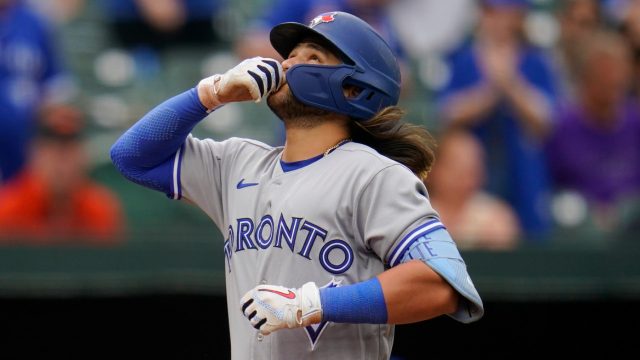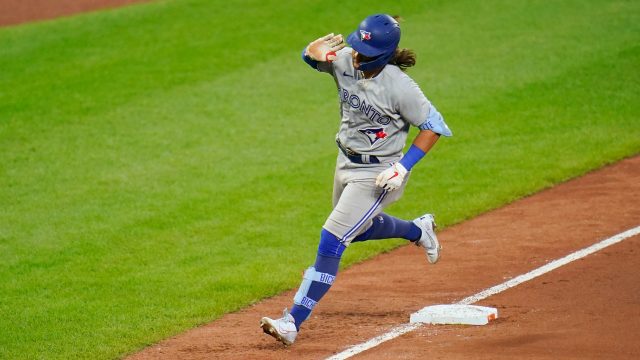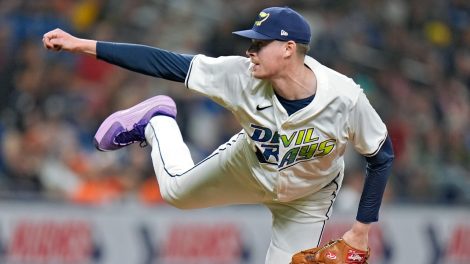When the Toronto Blue Jays had their last off-day, on September 1, it was fair to say that Bo Bichette was in the midst of a down season.
At that time the shortstop was hitting .260/.305/.420. Those numbers are good for a 106 wRC+, an above-average mark that plenty of players would be happy with. For Bichette — a guy who made the all-star team and got MVP votes in his age-23 season last year — they’re pedestrian at best.
Fast forward seven days and Bichette’s wRC+ (121) is almost precisely what he produced in 2021 (122). It’s not an exaggeration to say that his second full season in the major leagues has been completely re-contextualized.
We’re deep enough into the 2022 campaign that it doesn’t seem possible for the story of a player’s year to change on a dime like that — but that’s what a stretch hitting .515/.545/1.097 will do for you.
Bichette has produced impressive hot streaks before, but he’s never generated a wRC+ like this (369) over a seven-game span.
It’s always dangerous to put a microscope on a player when they’re in the midst of an extreme swing in performance. Mitch White for instance, isn’t nearly as bad as he looks right now. Similarly, Bichette isn’t as good as he looks at the moment, in part because no one ever has been in the history of the sport.
That doesn’t mean there isn’t anything to glean from how a player performs at their apex. It just takes a little sifting what simply can’t be replicated going forward and what might hint at how they can keep the good times rolling.
What looks like a fluke
The most common good fortune a player might experience during a hot streak like Bichette’s is an inflated BABIP (batting average on balls in play) due to weakly hit balls falling for hits. While the .524 BABIP the 24-year-old has sported during this stretch might seem lucky, he’s been scorching the ball.
Just three of his 16 hits had an xBA below .500, and only one fell below .400. Taking a look at that one supposedly fluky hit, xBA may be selling it short because it’s the type of ball that normally goes for a single when hit by a batter whom the defence isn’t shifting — like Bichette.
While Bichette hasn’t built this hot streak on soft singles, that doesn’t mean there isn’t some statistical wackiness involved. For example, his home run in the third inning on Tuesday left Camden Yards, but wouldn’t have escaped any other venture.
He’s also made contact at a remarkable rate that he simply won’t be able to replicate over a longer sample. You can’t fake putting the bat on the ball, but we’ve seen enough of Bichette to know approximately where his baseline is in that area. Until a two-strikeout Wednesday, the shortstop had an in-zone contact rate of 96.8 per cent during his hot streak. That would be a league-leading number if he’d posted it over a full season.
That type of number is an indicator of just how locked in Bichette has been, but it’s hard to see him transforming into Luis Arraez from a contact standpoint.
What could be a sign of what’s to come
The more interesting component of Bichette’s hot streak is the components of it he might be able to carry forward. That begins with his approach.
Bichette’s world-beating stretch has served as a powerful reminder that his aggression can be a strength, rather than a weakness.
Although he worked the odd long at-bat, every home run he hit came on the first or second pitch of a plate appearance. In a four-game span between Friday and Monday he hit half of his 2022 first-pitch home runs.
Doing damage in 0-0 counts has been a Bichette trademark, but his production had fallen off in that area coming into September compared to his previous seasons:
The success Bichette has with early-count aggressiveness could encourage him to pursue an approach that’s served him well in the past. It may result in a few wild swings, but the 24-year-old is at his best when he’s ambushing pitchers.
Bichette has also done an exceptional job of keeping the ball off the ground lately. He’s hit just five grounders in his last seven games for a groundball rate lower than he’s ever produced over a seven-game span (19.2%):
Because Bichette has solid wheels and he’s borderline unshiftable, it isn’t considered as much of a problem when he gets grounder-heavy as it is for Vladimir Guerrero Jr., but lifting the ball is critical to his success.
When he got off to a brutal start in April, slashing .213/.237/.298, it was paired with a bloated groundball percentage of 58.8. His worst month last season (August) also included a groundball rate above 50 percent (52.9%). When Bichette posts a healthy launch angle, strong production tends to follow — and he’s certainly done that lately with a 18.2 mark since the beginning of September.
It’s never going to be possible to make broad conclusions about a player from a week’s worth of production. For all the recent fireworks, it’s well within the realm of possibility that Bichette’s unremarkable Wednesday is the beginning of a lengthy slump.
Even so, Bichette’s world-beating performance in September — no matter how long it lasts — is giving us a glimpse of what makes the shortstop special. It may not prove that he’s taken a profound step forward, but at the very least it serves as a reminder of the player he can be.
For much of the year Bichette has been a diminished version of the guy we saw in 2021. Now he’s a guy who’s putting together another season that cements his reputation as one of the best hitting shortstops in the majors.















